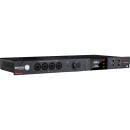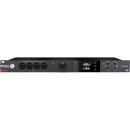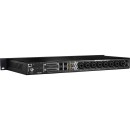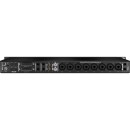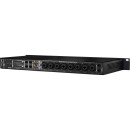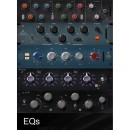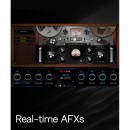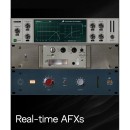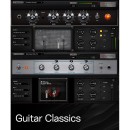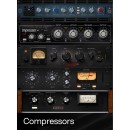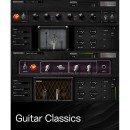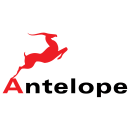Antelope Orion Studio Synergy Core Pro Audio Interface: A Comprehensive Review
- Ultra-low latency performance with Thunderbolt™ and USB connectivity.
- 32 channels of analog and digital I/O with ADAT and S/PDIF.
- Synergy Core effects processing with onboard DSP and FPGA for real-time effects.
- 12 discrete mic preamps with console-grade quality.
- 24-bit/192kHz audio resolution for pristine sound quality.
- Advanced clocking technology with 64-bit AFC jitter management.
- Comprehensive control software for routing, mixing, and effects management.
- Expandable system with additional effects and processing options.
- Robust build quality with a sleek, rack-mountable design.
Unveiling the Features and Performance of the Antelope Orion Studio Synergy Core
The Antelope Orion Studio Synergy Core is a professional-grade audio interface designed to deliver exceptional sound quality and performance for studio recording and production. It features advanced connectivity options, including Thunderbolt and USB, to ensure seamless integration with various digital audio workstations (DAWs) and other studio equipment. This interface is equipped with 12 high-quality microphone preamps, providing ample input options for capturing vocals and instruments with pristine clarity.
One of the standout features of the Orion Studio Synergy Core is its Synergy Core processing platform, which combines FPGA and DSP chips to offer real-time effects processing with low latency. This allows users to access a wide range of high-quality effects and signal processing tools without overloading their computer's CPU. The interface also includes a vast library of Antelope's renowned effects, such as EQs, compressors, reverbs, and more, providing users with versatile options for shaping their sound.
In addition to its powerful processing capabilities, the Orion Studio Synergy Core boasts an intuitive user interface with a color touchscreen display, making it easy to navigate settings and monitor levels. The interface also supports comprehensive monitoring and routing options, enabling users to create custom headphone mixes and manage complex studio setups efficiently. Overall, the Antelope Orion Studio Synergy Core is a versatile and powerful tool for audio professionals seeking high-quality sound and advanced processing capabilities in their recording environment.
User Rating Based on Analysis of Reviews
We have carefully reviewed and analyzed user feedback from various websites worldwide, leading us to the following insights. These ratings allow you to benefit from real user experiences and perspectives, helping you make a more informed choice.
Purchase Value
75% of users expressed satisfaction with the purchase value of the Antelope Orion Studio Synergy Core, noting that the interface offered a wide array of features and top-notch sound quality, which justified the cost. They appreciated the comprehensive suite of built-in effects and the ability to handle demanding recording tasks with ease, finding the investment worthwhile for the professional outcomes it facilitated.
25% of users were not satisfied with the purchase value, citing the high price as a significant barrier. They felt that although the interface was feature-rich, the investment did not match their expectations or needs, especially for those who required only basic functionalities. Some users also mentioned the need for additional purchases, such as plugins or accessories, which added to the overall cost.
Quality of Materials
80% of users praised the build quality of the Antelope Orion Studio Synergy Core, highlighting the durable construction and premium materials used. They found it to be robust and reliable, suitable for both studio and live settings. The solid feel and professional appearance contributed to their overall satisfaction, giving users confidence in the product's longevity.
20% of users were dissatisfied with the quality of materials, reporting issues such as wear and tear over time or problems with specific components like knobs and switches. Some users experienced hardware malfunctions that they attributed to suboptimal material choices, leading to frustration and concerns about the interface's durability.
Sound Quality
90% of users were highly satisfied with the sound quality delivered by the Antelope Orion Studio Synergy Core. They praised the clarity, depth, and detail of the audio, noting that the interface significantly enhanced their recording and mixing capabilities. The high-quality preamps and converters were frequently mentioned as standout features, contributing to an overall professional-grade audio experience.
10% of users expressed dissatisfaction with the sound quality, although this was mainly due to specific preferences or expectations not being met. Some users felt that the interface lacked warmth or character compared to other models they had used, while others experienced technical issues that affected audio performance, such as noise or interference.
Ease of Use
70% of users found the Antelope Orion Studio Synergy Core to be user-friendly, appreciating the intuitive interface and straightforward setup process. They valued the comprehensive manual and available online resources, which helped them quickly become familiar with the device's capabilities and features.
30% of users were dissatisfied with ease of use, pointing out a steep learning curve, especially for beginners. Some users encountered difficulties with the software integration and found the user interface complex and not very intuitive. Others mentioned that the abundance of features could be overwhelming, requiring significant time to master.
Customer Support
60% of users were satisfied with the customer support provided by Antelope Audio, appreciating the prompt responses and helpful solutions offered by the support team. They felt that the company's willingness to resolve issues and provide guidance was a positive aspect of their ownership experience.
40% of users expressed dissatisfaction with customer support, citing slow response times and unhelpful answers. Some users reported difficulties in reaching the support team or receiving clear instructions, which led to unresolved issues and frustration. These experiences negatively impacted their perception of the company's customer service quality.
Software Integration
65% of users were pleased with the software integration of the Antelope Orion Studio Synergy Core, noting that it worked well with major DAWs and offered a range of useful plugins and effects. The synergy between hardware and software was appreciated, allowing users to enhance their workflow with minimal hassle.
35% of users faced challenges with software integration, citing compatibility issues and frequent updates that sometimes caused problems with their existing setups. Some users found the software interface clunky or unintuitive, which hindered their ability to fully utilize the device's capabilities. These issues led to dissatisfaction and a more cumbersome user experience.
Latency Performance
85% of users were impressed by the low latency performance of the Antelope Orion Studio Synergy Core, which they felt was crucial for live monitoring and recording sessions. The device's ability to handle multiple tracks and effects without noticeable lag was a significant advantage, contributing to a smooth and efficient workflow.
15% of users reported dissatisfaction with latency performance, often due to individual setup issues or unexpected software interactions. These users experienced occasional latency spikes or delays, which disrupted their recording sessions and required troubleshooting to resolve. For some, this was a critical issue that impacted their overall satisfaction with the product.
Portability
55% of users found the Antelope Orion Studio Synergy Core reasonably portable, appreciating the relatively compact size for a high-end audio interface. They noted that while not the most portable option available, it was manageable for occasional transport between studio settings.
45% of users were dissatisfied with the portability, finding the device too bulky or heavy for regular transport. They mentioned the lack of convenient carrying options and the need for additional protection when moving the interface, which detracted from its suitability for mobile recording applications.
Durability
75% of users were satisfied with the durability of the Antelope Orion Studio Synergy Core, noting its sturdy construction and resilience to regular use. They felt that the materials and build quality ensured longevity, making it a reliable choice for demanding studio environments.
25% of users expressed concerns about durability, reporting issues such as component failure or cosmetic damage over time. Some users experienced problems with connectors or moving parts, raising questions about the long-term reliability of the interface in professional settings.
Flexibility
80% of users appreciated the flexibility offered by the Antelope Orion Studio Synergy Core, highlighting its ability to handle a wide range of recording and mixing tasks. The extensive I/O options and onboard effects provided users with numerous creative possibilities, enhancing their production capabilities.
20% of users found the flexibility lacking, often due to specific needs that the interface did not meet. Some users required more specialized features or connectivity options, which were unavailable or limited, leading to dissatisfaction and the need to explore additional equipment to fulfill their requirements.
Design Aesthetics
85% of users were satisfied with the design aesthetics of the Antelope Orion Studio Synergy Core, praising its sleek and professional appearance. The modern design and intuitive layout were appreciated, contributing to a positive impression and enhancing the studio environment.
15% of users were less impressed with the design aesthetics, finding the interface's appearance too minimalistic or lacking distinctive features. They felt that the design could have included more visual indicators or a more user-friendly control panel, impacting their overall satisfaction with the product's look and feel.
Compatibility with DAWs
70% of users were satisfied with the compatibility of the Antelope Orion Studio Synergy Core with various DAWs, appreciating its versatility and ease of integration into different recording setups. The interface's ability to work seamlessly with popular software platforms was a significant advantage for many users.
30% of users encountered compatibility issues with certain DAWs, facing challenges such as driver conflicts or limited functionality. These problems required workarounds or additional troubleshooting, which was frustrating for users expecting straightforward integration with their preferred software.
Expandability
75% of users appreciated the expandability options provided by the Antelope Orion Studio Synergy Core, noting the ability to connect additional gear and expand their studio setup. The interface's support for various digital connections allowed users to grow their systems as needed, enhancing their flexibility and creative potential.
25% of users were dissatisfied with expandability, citing limitations in available connection options or the need for additional equipment to achieve their desired setups. Some users felt constrained by the interface's design, requiring them to invest in supplementary gear to fully realize their recording ambitions.
Preamp Quality
90% of users were highly satisfied with the preamp quality of the Antelope Orion Studio Synergy Core, praising their transparency and ability to capture detailed audio with minimal noise. The high-quality preamps were frequently highlighted as a standout feature, contributing significantly to the overall sound performance and user satisfaction.
10% of users were less satisfied with the preamp quality, often due to personal preferences for a different tonal character or specific applications where the preamps did not meet their expectations. Some users compared the preamps unfavorably to other high-end models, seeking a different sound signature or performance characteristics.
Converters
85% of users were pleased with the converters in the Antelope Orion Studio Synergy Core, noting their accuracy and ability to deliver high-resolution audio. The converters were seen as a key factor in achieving professional-grade recordings, with users appreciating the clarity and precision they provided.
15% of users expressed dissatisfaction with the converters, often due to specific technical requirements or expectations that were not met. Some users experienced issues with dynamic range or distortion at certain settings, leading to concerns about the interface's suitability for their particular recording needs.
Onboard Effects
80% of users enjoyed the onboard effects offered by the Antelope Orion Studio Synergy Core, finding them versatile and high-quality. The inclusion of a wide range of effects enhanced their creative possibilities and allowed for in-depth sound shaping without additional plugins.
20% of users were dissatisfied with the onboard effects, noting limitations in the selection or quality compared to third-party plugins. Some users found the effects difficult to use or integrate into their workflow, reducing their perceived value and utility within the interface's feature set.
Firmware Updates
65% of users were satisfied with the firmware update process for the Antelope Orion Studio Synergy Core, appreciating the regular improvements and new features provided through updates. The updates were seen as a way to enhance the device's performance and longevity, adding value to their investment.
35% of users experienced dissatisfaction with firmware updates, often due to issues such as bugs introduced with new versions or a complex update process. Some users reported disruptions to their workflow or system compatibility problems following updates, leading to frustration and a cautious approach to future updates.
Value for Money
70% of users believed the Antelope Orion Studio Synergy Core offered good value for money, given its extensive feature set and high-quality performance. They felt that the investment was justified by the professional results achieved and the interface's versatility across various applications.
30% of users were dissatisfied with the value for money, often due to the high initial cost and the need for additional purchases to fully utilize the interface's capabilities. Some users felt that comparable alternatives offered similar performance at a lower price point, questioning the premium pricing of the product.
Technical Support
60% of users found the technical support for the Antelope Orion Studio Synergy Core to be helpful and responsive, appreciating the assistance provided in resolving technical issues and optimizing their setup. The support team was seen as knowledgeable and committed to ensuring a positive user experience.
40% of users were dissatisfied with technical support, citing slow response times or ineffective solutions to their problems. Some users felt that their issues were not adequately addressed or required multiple follow-ups to receive satisfactory assistance, leading to frustration and decreased confidence in the support services offered.
User Community
75% of users appreciated the active user community surrounding the Antelope Orion Studio Synergy Core, finding it a valuable resource for tips, advice, and troubleshooting. The community was seen as supportive and knowledgeable, enhancing the overall ownership experience by providing additional insights and solutions.
25% of users felt that the user community was lacking in specific areas, such as detailed tutorials or advanced usage guidance. Some users found it challenging to find relevant information or connect with others who had similar needs, reducing the perceived value of the community as a support network.
Overall Satisfaction
80% of users expressed overall satisfaction with the Antelope Orion Studio Synergy Core, highlighting its high-quality sound, versatility, and professional-grade features as key reasons for their positive experience. The interface met or exceeded their expectations, providing a reliable and effective solution for their audio production needs.
20% of users were not fully satisfied with their experience, often due to specific issues such as customer support, software integration, or value for money. These users felt that while the interface had potential, certain aspects detracted from their overall satisfaction and required improvements to meet their expectations fully.
In the following sections, we will delve into the detailed specifications of the Antelope Orion Studio Synergy Core Pro Audio Interface, providing a thorough analysis of its features, as well as discussing the advantages and disadvantages of this product.
Pros:
- High-quality audio conversion with 24-bit/192kHz resolution.
- Includes a wide range of DSP and FPGA effects for real-time processing.
- Multiple connectivity options including Thunderbolt and USB for flexibility.
- Features 12 discrete preamps for superior microphone recording quality.
- Comes with a large collection of included effects and virtual instruments.
Cons:
- Premium price point, which might be prohibitive for some users.
- Complex setup and software may have a steep learning curve for beginners.
- Requires a powerful computer to fully utilize all features and processing capabilities.
- Limited portability due to its size and studio-focused design.
- Some users may find the control panel software interface to be less intuitive.
General
| Channels of I/O | Thunderbolt: 32 Input / 32 Output USB: 24 Input / 24 Output Analog: 14 Input / 24 Output |
|---|---|
| Maximum Sampling Rate | 192 kHz / 24-Bit |
| Number of Microphone Inputs | 12 |
| Built-In Microphone | Yes |
| Input Level Adjustment | 1x Knob |
| Expansion Slots |
Channels of I/O: This specification indicates the number of input and output channels available for audio routing. The Antelope Orion Studio Synergy Core offers a robust configuration with 32 inputs and outputs via Thunderbolt, and 24 each via USB. Additionally, it features 14 analog inputs and 24 outputs. This extensive I/O capability allows for complex audio setups, making it suitable for professional studios that require multiple audio sources and destinations simultaneously.Show More
Maximum Sampling Rate: The maximum sampling rate of 192 kHz at 24-bit signifies the interface's ability to capture high-resolution audio signals. This high sampling rate ensures that recordings maintain a high level of detail and fidelity, which is crucial for professional music production and mixing. The combination of a high sampling rate and bit depth allows for greater dynamic range and lower noise floor in recordings.
Number of Microphone Inputs: With 12 microphone inputs, the Orion Studio Synergy Core provides ample capacity for recording multiple vocalists or instruments at once. This feature is particularly valuable for live recordings, ensemble tracking, or any situation where multiple microphones need to be connected simultaneously. More microphone inputs enable greater flexibility and creativity in audio capture.
Built-In Microphone: The presence of a built-in microphone offers convenience for quick recordings or voiceovers. This feature can be particularly useful for podcasters or content creators who need an easy way to capture audio without requiring additional external microphones.
Input Level Adjustment: The specification indicating a 1x knob for input level adjustment allows users to easily control the gain of incoming signals. This feature is essential for achieving optimal recording levels, preventing distortion while ensuring that signals are strong enough for processing. A simple knob interface makes it user-friendly, especially in dynamic recording situations.
Expansion Slots: The absence of expansion slots means that the Orion Studio Synergy Core does not support additional hardware upgrades for expanding its capabilities. However, this design choice simplifies the interface and ensures that users can rely on the built-in features without needing to invest in further enhancements. This makes it a cost-effective solution for those who require a high-quality audio interface without the complexity of modular upgrades.
Signal Processing
| Pad | |
|---|---|
| Gain/Trim Range | AD/DA Converters: Up to 130 dB Combo XLR-1/4" Mic Inputs: 75 dB |
| High-Pass Filter | |
| Solo/Mute |
Pad: The absence of a pad feature means that the Antelope Orion Studio Synergy Core does not offer a built-in attenuation option for its inputs. A pad can help reduce the signal level from high-output sources, preventing distortion during recording. Without this feature, users may need to manage levels more carefully to avoid clipping when using particularly strong microphones or instruments.Show More
Gain/Trim Range: The gain/trim range of the AD/DA converters, which is up to 130 dB, indicates the range of gain adjustments available during audio processing. A higher gain range allows for greater flexibility in capturing both very quiet and very loud sound sources without losing detail or introducing noise. This capability is particularly beneficial in professional audio environments, where dynamic range is crucial for high-quality recordings.
Combo XLR-1/4" Mic Inputs: With a gain of 75 dB available for the combo XLR-1/4" mic inputs, users can connect a variety of microphones and instruments. This level of gain is sufficient for most audio sources, making it versatile for both studio and live applications. It ensures that even low-sensitivity microphones can produce a strong enough signal for optimal processing.
High-Pass Filter: The absence of a high-pass filter indicates that this interface does not provide a built-in option to reduce low-frequency noise or rumble. A high-pass filter can be valuable in cleaning up recordings by eliminating unwanted low-frequency sounds. Without this feature, users may need to apply EQ during mixing to achieve a similar effect, which could add more steps to the workflow.
Solo/Mute: The lack of solo/mute functionality means that users cannot isolate or silence individual channels directly on the interface. This feature is often used in mixing to focus on specific tracks without interference from others. Without it, users may need to rely on their DAW for similar control, which can be less intuitive during live sessions or quick adjustments.
Connectivity
| Analog Audio I/O | 8x Combo XLR-1/4" TRS Mic/Line Input (DC-Coupled) 4x Combo XLR-1/4" TRS Mic/Line/Hi-Z Input 2x 1/4" TRS Insert Input 2x 1/4" TRS Headphone Output 4x 1/4" TRS Monitor Output 2x 1/4" TRS Re-Amp Output 2x DB-25 25-Pin Line/8-Channel Output |
|---|---|
| Digital Audio I/O | 2x TOSLINK Optical ADAT Input 2x TOSLINK Optical ADAT Output 1x RCA Coaxial S/PDIF Input 1x RCA Coaxial S/PDIF Output |
| Host Connection | 1x USB-C 1x USB-B |
| Host Connection Protocol | Thunderbolt 3 USB 2.0 |
| USB (Non-Host) | |
| Sync I/O | 1x BNC Word Clock Input 1x BNC Word Clock Output |
| Network I/O | |
| MIDI I/O | |
| Wireless | Wi-Fi |
The Analog Audio I/O section of the Antelope Orion Studio Synergy Core Pro Audio Interface highlights its extensive input and output capabilities. With 8x combo XLR-1/4" TRS mic/line inputs, users can connect a variety of microphones and instruments, making it versatile for different recording scenarios. The inclusion of Hi-Z inputs allows for direct connection of electric guitars and basses. Additionally, the interface features multiple outputs, including headphone and monitor outputs, which facilitate accurate monitoring during recording sessions.Show More
The Digital Audio I/O section showcases the interface's ability to connect with other digital equipment. With 2x TOSLINK Optical ADAT inputs and outputs, users can expand their system by linking additional ADAT-compatible devices. The RCA Coaxial S/PDIF inputs and outputs further enhance digital connectivity options, allowing for high-quality digital audio transfer between devices, which is essential for professional audio production environments.
In the Host Connection category, the presence of USB-C and USB-B ports ensures compatibility with modern computers and devices, while the Thunderbolt 3 and USB 2.0 protocols provide high-speed data transfer. This feature is critical for maintaining low latency during audio processing, which is a key factor in live recording and mixing scenarios.
The Sync I/O section includes BNC word clock inputs and outputs, which are vital for synchronizing multiple digital audio devices. This feature helps maintain sample rate accuracy across all connected devices, which is crucial for avoiding audio glitches and ensuring seamless integration in complex setups.
The interface does not include Network I/O or MIDI I/O, indicating a focus primarily on audio connections rather than networked or MIDI capabilities. However, it does support Wireless connectivity through Wi-Fi, which can facilitate remote control and setup options, adding an element of convenience for users working in dynamic environments.
Performance
| Maximum Input Level | Mic Inputs: +18 dBu |
|---|---|
| Dynamic Range | A/D Converters: 124 dB D/A Converters: 128 dB Monitor D/A Converters: 130 dB |
| THD | Mic: -106 dB |
| THD+N | A/D Converters: -112 dB D/A Converters: -115 dB Monitor D/A Converters: -115 dB |
| EIN | Combo XLR-1/4" Mic Inputs: -128 dBu |
The Maximum Input Level indicates the highest signal level that the interface can handle without distortion. For mic inputs, a level of +18 dBu means that the device can accommodate strong input signals from microphones without clipping, ensuring clear sound reproduction even with loud sources. This is particularly important in professional audio environments where dynamic range can be significant.Show More
Dynamic Range is a critical specification that reflects the difference between the smallest and largest signal levels that the converters can process. The A/D converters having a dynamic range of 124 dB allows for capturing subtle audio details alongside louder sounds, making it ideal for high-fidelity recordings. The D/A converters with a dynamic range of 128 dB and monitor D/A converters at 130 dB enhance playback quality by ensuring that even the softest sounds are rendered accurately, which is vital for mixing and mastering processes.
THD, or Total Harmonic Distortion, measures the distortion introduced by the device when processing audio signals. The mic THD value of -106 dB suggests that the interface maintains high fidelity when recording, as lower distortion leads to a more accurate representation of the original sound. For the A/D and D/A converters, THD+N readings of -112 dB and -115 dB respectively indicate exceptional performance, meaning that the audio remains clean and true to the source, which is essential for professional audio applications.
EIN stands for Equivalent Input Noise, which quantifies the noise floor of the mic inputs. A rating of -128 dBu for the combo XLR-1/4" mic inputs signifies that the interface is capable of very low noise operation, ensuring that recordings are free from unwanted background noise. This is crucial for achieving pristine audio quality, especially in sensitive recording situations where quiet sources are involved.
Digital Audio
| Sample Rates | Up to 192 kHz |
|---|---|
| Bit Depths | Up to 64-Bit |
| Sync Sources | DB-25, Internal |
| Clocking | Internal: Accuracy: ±0.2 ppm |
Sample Rates refer to the number of samples of audio carried per second, measured in kilohertz (kHz). The Orion Studio Synergy Core supports sample rates up to 192 kHz, which means it can capture audio with high fidelity and detail. Higher sample rates provide a greater frequency response and can result in clearer sound, especially important for professional recording and mixing environments. This capability is essential for users seeking to produce high-quality audio, whether for music, film, or broadcasting.Show More
Bit Depths indicate the number of bits used for each audio sample, with the Orion Studio offering up to 64-bit resolution. A higher bit depth allows for a greater dynamic range, meaning it can accurately capture quieter sounds and manage louder sounds without distortion. This feature is particularly beneficial in professional audio settings where maintaining audio integrity is crucial throughout the recording and mixing process.
Sync Sources denote the various methods through which the interface can synchronize its clock with other devices, utilizing DB-25 connections, internal sources, and more. This versatility in sync sources ensures that the audio interface can work seamlessly with other equipment in a studio environment, preventing timing issues and ensuring that all devices operate in perfect harmony, which is vital for multi-device setups.
Clocking refers to the accuracy of the internal clock used to time the audio samples. The Orion Studio boasts an internal clock accuracy of ±0.2 ppm (parts per million), which indicates a very stable clock source. Precise clocking is critical in digital audio systems as it minimizes jitter, ensuring that the timing of the audio playback and recording is precise. This feature is particularly important for maintaining audio quality during complex productions where multiple tracks and devices are involved.
Audio Storage & Playback
| Media/Memory Card Slot |
|---|
The Antelope Orion Studio Synergy Core Pro Audio Interface does not feature a media or memory card slot. This means that users cannot directly insert memory cards to expand storage or manage audio files. Instead, the interface is designed to operate primarily through USB or other connection types, relying on the host computer's storage capabilities for data management. This design choice simplifies the interface's layout and focuses on delivering high-quality audio processing without additional hardware complexity.Show More
By not including a media or memory card slot, the Orion Studio Synergy Core emphasizes its role as a professional audio interface rather than a standalone recording device. Users typically connect the interface to a computer or DAW (Digital Audio Workstation), where they can manage and store their recordings. This approach allows for more flexibility and larger storage options, as users can utilize the existing hard drives or SSDs of their computers for extensive audio projects.
Compatibility
| OS Compatibility | macOS 10.12 or Later Windows 10 or Later (64-Bit Only) |
|---|---|
| RAM Requirements | 4 GB, 8 GB Recommended |
| Storage Requirements | 4 GB |
| Mobile Device Compatibility |
OS Compatibility refers to the operating systems that the Antelope Orion Studio Synergy Core Pro Audio Interface can function with. This device is compatible with macOS versions starting from 10.12 and later, as well as Windows 10 (64-Bit only). This specification is crucial for users to ensure that their computer environment supports the interface, allowing for seamless integration and optimal performance during audio production tasks.Show More
RAM Requirements indicate the amount of random access memory that is necessary for the device to operate efficiently. The minimum requirement is 4 GB, while 8 GB is recommended for a better experience. Adequate RAM is essential for handling multiple audio tracks and plugins simultaneously, especially in professional audio production settings where efficiency and processing power are paramount.
Storage Requirements reflect the amount of disk space needed to install the necessary software and drivers for the interface. With a requirement of 4 GB, this allows for the installation of the essential components that enable the device to function properly. Having sufficient storage is important to ensure that users can not only install the software but also have room for any additional audio files or projects they may be working on.
Mobile Device Compatibility indicates whether the interface can be used with mobile devices. In this case, the Antelope Orion Studio Synergy Core Pro Audio Interface does not support mobile device compatibility. This means that users will need to connect the interface to a desktop or laptop computer to utilize its features, which is important to consider for those looking for a portable audio solution.
Power
| Power Requirements | AC/DC Power Adapter (Included) |
|---|---|
| AC Input Power | 18 VAC, 60 Hz |
| Power Consumption | 25 W |
Power Requirements refer to the specifications that indicate how the Antelope Orion Studio Synergy Core Pro Audio Interface is powered. It utilizes an AC/DC power adapter, which is included with the device. This ensures that users have everything they need to operate the interface right out of the box, eliminating the need for additional purchases. The power adapter converts the AC power from a wall outlet into the appropriate DC voltage needed for the device to function effectively.Show More
The AC Input Power specification, which is rated at 18 VAC, specifies the type of power input required for the device to operate. This voltage rating is crucial for ensuring that the interface receives the correct amount of power for optimal performance. Operating at the specified voltage helps prevent damage to the device and ensures that it functions as intended, delivering high-quality audio processing.
Power Consumption indicates the amount of electrical power the device uses during operation, measured in watts (W). In this case, the Antelope Orion Studio Synergy Core has a power consumption of 25 W. This value is important for users to consider, especially in terms of energy efficiency and heat generation. A lower power consumption can contribute to a more eco-friendly setup and can also extend the lifespan of the device by reducing heat stress.
Physical
| Rackmount Size | 1 RU |
|---|---|
| Operating Temperature | 32 to 122°F / 0 to 50°C |
| Dimensions | 19 x 8.6 x 1.7" / 48.3 x 21.8 x 4.3 cm |
| Weight | 6.8 lb / 3.1 kg |
Rackmount Size: The Antelope Orion Studio Synergy Core Pro Audio Interface is designed to fit in a standard 1 RU (rack unit) space. This compact size allows it to be easily integrated into existing studio setups, maximizing space efficiency while providing essential audio processing capabilities. A 1 RU height is a common standard in professional audio equipment, making it suitable for both studio and live performance environments.Show More
Operating Temperature: The device operates effectively within a temperature range of 32 to 122°F (0 to 50°C). This specification is crucial for ensuring reliable performance in various environments, whether in a controlled studio setting or a more variable live performance scenario. Maintaining the device within this temperature range helps prevent overheating and ensures optimal functionality during extended use.
Dimensions: With dimensions of 19 x 8.6 x 1.7 inches (48.3 x 21.8 x 4.3 cm), the Orion Studio Synergy Core is designed to fit snugly in standard 19-inch racks. Its relatively slim profile, combined with a depth that allows for adequate airflow, makes it versatile for use in both professional and home studios. These dimensions are important for users who are considering their studio layout and equipment arrangement.
Weight: Weighing in at 6.8 lb (3.1 kg), the Orion Studio Synergy Core strikes a balance between portability and durability. This weight makes it manageable for transport, while still ensuring it is robust enough for regular use in studio settings. The weight is an important consideration for mobile professionals who may need to move their equipment frequently without sacrificing build quality.
Packaging Info
| Package Weight | 12.065 lb |
|---|---|
| Box Dimensions (LxWxH) | 25 x 13.5 x 4.5" |
Package Weight: The weight of the Antelope Orion Studio Synergy Core Pro Audio Interface is 12.065 lb. This weight can affect shipping costs and portability, making it important for users who may need to transport the unit for gigs or studio sessions. A heavier interface might suggest a more robust build quality or inclusion of additional features, which can enhance its durability and reliability in various settings.Show More
Box Dimensions (LxWxH): Measuring 25 x 13.5 x 4.5 inches, the box dimensions indicate the physical size of the packaging for the audio interface. This is significant for storage and transport considerations, ensuring that users have adequate space to accommodate the unit. The dimensions also reflect the design of the interface itself, providing insight into its compactness and how it may fit into existing studio setups or mobile rigs.
Customer Images
Videos
Customer Questions
How do I install the drivers for the Antelope Orion Studio Synergy Core?
To install the drivers for the Antelope Orion Studio Synergy Core, visit the Antelope Audio website, navigate to the Support section, and download the latest drivers for your operating system. Once downloaded, run the installer and follow the on-screen instructions.
Why is my computer not recognizing the Orion Studio Synergy Core?
Ensure that the USB or Thunderbolt cable is securely connected to both the interface and your computer. Try using a different port or cable, and make sure the drivers are properly installed. Restart your computer after installing drivers.
How do I update the firmware on my Orion Studio Synergy Core?
Open the Antelope Launcher application, connect your device, and select it from the list. If a firmware update is available, you will see an update button. Click it and follow the instructions to complete the update.
Why am I not getting any sound from my Orion Studio Synergy Core?
Check that your speakers or headphones are properly connected to the output section of the interface. Verify that the correct output is selected in both your DAW and the Antelope Control Panel. Also, ensure that the volume levels are not muted or set too low.
How do I configure the Orion Studio Synergy Core with my DAW?
In your DAW, go to the audio settings/preferences and select the Orion Studio Synergy Core as the audio input and output device. Ensure your DAW is set to the appropriate sample rate and buffer size for optimal performance.
How can I reduce latency when using the Orion Studio Synergy Core?
To reduce latency, lower the buffer size in your DAW's audio settings. You can also use the onboard DSP effects of the Synergy Core to monitor with zero latency.
Can I use the Orion Studio Synergy Core with a Mac computer?
Yes, the Orion Studio Synergy Core is compatible with Mac computers. Ensure you download the Mac-specific drivers and follow the installation instructions provided by Antelope Audio.
What should I do if the Orion Studio Synergy Core is producing distorted audio?
Check if the input levels are too high and causing clipping. Lower the gain on the preamps. Also, ensure that the sample rate and bit depth settings in your DAW match those of the interface to avoid any digital distortion.
How do I connect external hardware to the Orion Studio Synergy Core?
Use the available line inputs and outputs on the Orion Studio Synergy Core to connect external hardware. Use the Antelope Control Panel to route audio to and from the external devices.
How do I reset the Orion Studio Synergy Core to factory settings?
To reset the Orion Studio Synergy Core to factory settings, open the Antelope Control Panel, go to the system settings, and select the option to reset to factory defaults. Confirm the action to complete the reset.
